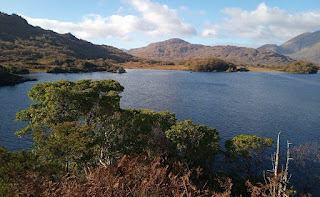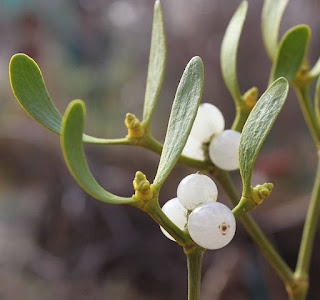 |
| Strawberry Tree overhanging the water: Upper Lake, Killarney, Co. Kerry Image: R. Hodd |
"Several papers published previously in British & Irish Botany have helped to elucidate the origins of our flora through combining knowledge of present-day distributions with considerations of history and pre-history, and even folklore and mythology. Opening papers to the current issue apply such a multidisciplinary approach to two of the most iconic members of the British and Irish flora.
"Strawberry Tree Arbutus unedo is one of the
so-called ‘Lusitanian’ species occurring disjunctly in western Ireland and the
Iberian Peninsula, and whose origins have been hotly debated. Micheline Sheehy Skeffington (BSBI’s new President-elect!) and Nick Scott present compelling
evidence that Arbutus, in County Kerry at least, was introduced by copper
miners arriving in Ireland in the late Neolithic. Coupled with Micheline’s
other research on western Ireland specialities, this reinforces a likelihood
that each of the Lusitanian species, far from having a homogeneous
phytogeographical origin, has an idiosyncratic story to tell.
 |
| Mistletoe in fruit Image: J. Briggs |
"On a seasonal note, Jonathan Briggs reviews in detail the
biology, range, uses and conservation status of mistletoe, Viscum album. As one
of the leading world authorities on this species, Jonathan is well placed to
attempt to disentangle occurrences that are native from one resulting from its
widespread cultivation (to support its traditional role in Christmas festivities!).
"Returning to an Irish theme, Dan Minchin and colleagues document the expansion of a colony of Water-soldier Stratiotes aloides on the shore of Lough Derg, County Galway. The colony was monitored over 13 years by surface observations supplemented by satellite images and a GPS-enabled drone – tasks that are complicated by most emergent plants descending below the surface during winter.
"Willowherbs Epilobium spp. are well known for their propensity to hybridise. BSBI expert plant referee Geoffrey Kitchener and colleagues report on new hybrid combinations for Britain involving a non-native, strikingly large-flowered subspecies of Square-stemmed Willowherb E. tetragonum subsp. tournefortii that is established on roadsides in Cambridgeshire and Bedfordshire. |
| Tournefort's Willowherb on the right; an intermediate hybrid on the left. Image: P. Leonard |
"In the final paper, Alastair Fitter and colleagues, including BSBI Head of Science Kevin Walker, detail the
occurrence and ecology of the very local Gingerbread Sedge Carex elongata in
Yorkshire, paying particular attention to a recent and substantial increase of
this plant at Askham Bog near York. This expansion is not only welcome but also
topical given that BSBI participated in a recent successful campaign to oppose a
housing development in close proximity to the nature reserve".
So, another jam-packed issue with something for everyone. British & Irish Botany is free to read (and free for authors to publish in) and there's no log in required - just head over here to start enjoying the latest issue and then why not browse our archive? We are now accepting submissions for the first issue of volume four in 2022, so why not get in touch if you are thinking of contributing? Meanwhile, a very Happy New Year from all of us here at British & Irish Botany!
No comments:
Post a Comment
Please leave a comment!